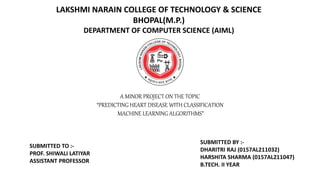
MINOR PROJECT.pptx
- 1. A MINOR PROJECT ON THE TOPIC “PREDICTING HEART DISEASE WITH CLASSIFICATION MACHINE LEARNING ALGORITHMS” LAKSHMI NARAIN COLLEGE OF TECHNOLOGY & SCIENCE BHOPAL(M.P.) DEPARTMENT OF COMPUTER SCIENCE (AIML) SUBMITTED TO :- PROF. SHIWALI LATIYAR ASSISTANT PROFESSOR SUBMITTED BY :- DHARITRI RAJ (0157AL211032) HARSHITA SHARMA (0157AL211047) B.TECH. II YEAR
- 2. Heart-y Predictions: How Machine Learning Can Keep Your Heart in Check
- 3. Introduction: - Heart disease is a major health concern worldwide,and predicting its occurrence is crucial for early intervention and prevention. - Machine learning algorithms offer promising solutions for accurate prediction of heart disease based on patient data.
- 4. Problem Statement: - The challenge lies in developing an accurate classification model that can reliably identify the presence of heart disease based on various patient attributes. - The goal is to create a robust tool that can assist healthcare professionals in making informed decisions and providing timely interventions.
- 5. Libraries Used: - Python libraries such as scikit-learn, pandas, and numpy are widely utilized in implementing heart disease prediction models. - These libraries provide essential functions for data preprocessing, feature selection, model training, and evaluation.
- 6. M odel Construction: -The heart disease prediction model is built using classification machine learning algorithms like logistic regression, support vector machines, or random forests. - Relevant patient data,such as age, cholesterol levels, blood pressure, and electrocardiogram results, are utilized as input features.
- 7. Predictive Capability: - Once trained on labeled data,the model can accurately predict the likelihood of heart disease in new, unseen patient cases. - By inputting patient information into the model,it can analyze the data and provide a probability or binary prediction indicating the presence of heart disease.
- 8. FutureImplications: -The heart disease prediction model has significant implications for healthcare, enabling early detection and intervention. -It can aid healthcare providers in making informed decisions, reducing the risk of complications and improving patient outcomes. -Additionally, the model's insights and findings can contribute to medical research, furthering our understanding of heart disease risk factors and prevention strategies.
- 9. H ear tfelt T h an k s !